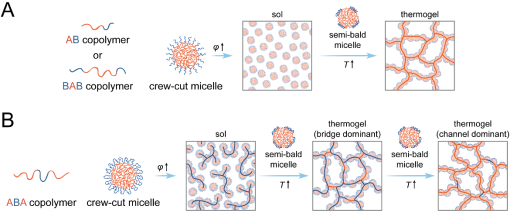 +565 975 658
+565 975 658
 info@premiumcoding.com
info@premiumcoding.com
 Monday - Friday, 8.00 - 20.00
Monday - Friday, 8.00 - 20.00
Some amphiphilic copolymers, such as block copolymers of polyethylene (PEG) and poly(D,L-lactide-co-glycolide) (PLGA), in water can undergo a reversible physical sol-gel transition upon heating. The temperature-induced sol-gel transition makes the system maintain a sol state at room temperature and thus can be mixed with drugs or cells conveniently, but transform into a gel after being injected into the body. The physical thermogelation avoids the by-products from the chemical reaction and suppresses the possible resulting inflammatory responds. These novel properties endow this material with great potential in clinic. Nevertheless, the structure and mechanism of the thermogel are still unclear, which limits its application and further modification.
Based on experiments and computer simulations, Ding’s group has been studying the intrinsic structure and mechanism behind the thermogelling of PEG/PLGA copolymers. In their previous work, a new type of micelle, semi-bald micelle was proposed to occur along the thermogelation of the aqueous system of diblock copolymer mPEG-PLGA (AB type).
In the present work, the thermogelling behavior of PLGA-PEG-PLGA triblock copolymer (ABA type) was revealed and compared with other types of copolymers. Crew-cut micelles form in water by the self-assembly of copolymers in water. According to the structure of ABA type copolymer, different crew-cut micelles are associated together by the hydrophilic bridge of the middle PEG block. With an increase of temperature, the corona collapses owing to the reverse thermosensitivity of the PEG. If the collapsed corona in an original crew-cut micelle cannot totally wrap the core, a semi-bald micelle is formed. The exposed hydrophobic areas of different micellar cores might contact to reduce the total exposed area, which promotes the aggregation. A hydrophobic channel at the core-to-core position is formed.
According to the dominant type of the cross-linking point, the hydrophilic bridge or the hydrophobic channel, there might be two thermogel states in the ABA copolymer aqueous system. The key evolution triggering thermogelling of ABA copolymer (for both of these two states) is still the formation of the hydrophobic channel evolved from the semi-bald micelle, which is consistent to the thermogelling of AB or BAB copolymer system.
Based on the universal mechanism, Ding’s group proposed the corresponding prerequisites for the design of the thermogellable system via molecular engineering of polymers.

This work with both experimental and theoretical studies was just published on Macromolecules with a PhD candidate Mr. Shuquan CUI as the first author. See please: Shuquan Cui, Lin Yu and Jiandong Ding*, Thermogelling of Amphiphilic Block Copolymers in Water: ABA Type versus AB or BAB Type, Macromolecules, 10.1021/acs.macromol.9b00534.
Article links: https://pubs.acs.org.ccindex.cn/doi/pdf/10.1021/acs.macromol.9b00534
Get to know us better now!

Wechat:FDUMMers
Search!
Search across our website
Revenant @ 2018 by fudan | All Rights Reserved
Powered by Weicheng

